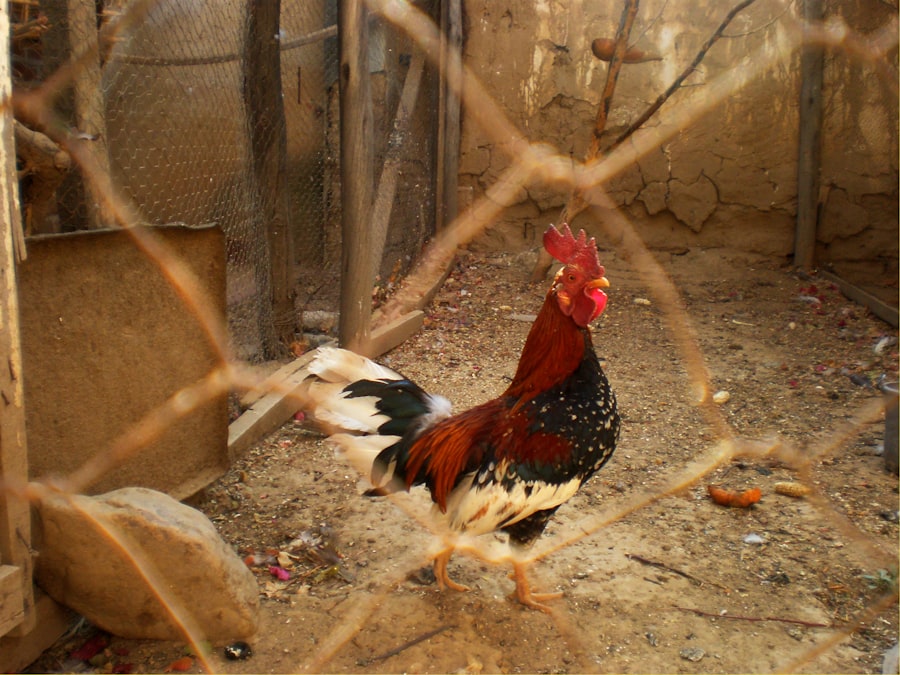Cats are renowned for their inquisitive and autonomous nature. As natural predators, they are often drawn to small animals, including chickens. Cats are territorial creatures and may view a yard containing chickens as a potential hunting area.
Conversely, chickens are gregarious animals that enjoy foraging and pecking at the ground. They are easily frightened by sudden movements or sounds, which can make them susceptible to predators such as cats. A thorough understanding of both cat and chicken behavior is essential for developing effective separation strategies.
Cats possess remarkable agility and stealth, enabling them to easily scale fences or slip through small openings. While chickens are less agile, they can still find ways to escape their enclosures if given the chance. Recognizing the behavioral characteristics of both species reveals that physical barriers alone may be insufficient for keeping them apart.
When implementing strategies to separate cats from chickens, it is crucial to consider their innate instincts and behavioral tendencies.
Table of Contents
- 1 Creating Physical Barriers to Keep Cats and Chickens Out
- 2 Using Natural Deterrents to Repel Cats and Chickens
- 3 Implementing Scare Tactics to Keep Cats and Chickens Away
- 4 Providing Alternative Attractions for Cats and Chickens
- 5 Collaborating with Neighbors to Address the Issue
- 6 Seeking Professional Help if the Problem Persists
- 7 FAQs
- 7.1 What are some effective ways to keep cats out of your yard?
- 7.2 How can I keep chickens out of my yard?
- 7.3 Are there any natural deterrents to keep cats and chickens out of my yard?
- 7.4 What are some common mistakes to avoid when trying to keep cats and chickens out of your yard?
- 7.5 Are there any humane ways to keep cats and chickens out of my yard?
Key Takeaways
- Cats and chickens have different behaviors and motivations for entering certain areas
- Physical barriers such as fences and netting can effectively keep cats and chickens out of specific areas
- Natural deterrents like citrus peels and coffee grounds can be used to repel cats and chickens
- Scare tactics such as motion-activated sprinklers and noise-making devices can be effective in keeping cats and chickens away
- Providing alternative attractions like designated areas for scratching and pecking can redirect cats and chickens away from unwanted areas
- Collaborating with neighbors to address the issue can lead to a more comprehensive and effective solution
- Seeking professional help from animal control or pest management services may be necessary if the problem persists
Creating Physical Barriers to Keep Cats and Chickens Out
Keeping cats away from chickens requires a multi-faceted approach, and one of the most effective methods is to create physical barriers.
Fencing and Enclosure
Installing fences around the chicken coop and run is a crucial step in preventing cats from gaining access. The fencing material should be sturdy and tall enough to deter cats from jumping over. Additionally, adding a roof or netting over the chicken enclosure can further prevent cats from entering from above.
Securing the Perimeter
Cats that try to dig under the fence can be deterred by burying wire mesh or hardware cloth along the perimeter. Regular inspections of the fencing are also necessary to identify and repair any gaps or weak spots that cats could exploit.
Securing the Coop
In addition to fencing, it is essential to secure the chicken coop with latches and locks that are out of reach for cats. This will prevent them from being able to open doors or windows to gain access to the chickens. By creating physical barriers both around the chicken enclosure and within the coop itself, it becomes much harder for cats to reach the chickens.
Using Natural Deterrents to Repel Cats and Chickens

In addition to physical barriers, natural deterrents can be used to repel both cats and chickens. Cats are known to dislike certain scents such as citrus, lavender, or peppermint. By planting these types of plants around the perimeter of the chicken enclosure, it can help deter cats from coming too close.
Additionally, spreading citrus peels or using essential oils with these scents can further discourage cats from entering the area. For chickens, natural deterrents can also be effective in keeping them away from areas where they are not wanted. For example, scattering coffee grounds or cayenne pepper around plants or areas where chickens tend to roam can help deter them from pecking at these areas.
It is important to use natural deterrents that are safe for both cats and chickens and will not cause harm to either animal. Another natural deterrent that can be effective in repelling both cats and chickens is the use of motion-activated sprinklers. These devices can be set up around the perimeter of the chicken enclosure and will spray water when they detect movement.
This can startle both cats and chickens, making them less likely to approach the area. By using natural deterrents, it is possible to repel both cats and chickens without causing harm to either animal.
Implementing Scare Tactics to Keep Cats and Chickens Away
Scare tactics can also be effective in keeping cats and chickens separated. For cats, motion-activated ultrasonic devices can emit high-frequency sounds that are unpleasant for cats but inaudible to humans. These devices can be placed around the perimeter of the chicken enclosure and will deter cats from approaching the area.
Additionally, placing objects that move in the wind, such as pinwheels or wind chimes, can also startle cats and make them less likely to enter the area. For chickens, scare tactics can include using visual deterrents such as scarecrows or reflective objects that move in the wind. These objects can create a sense of unease for chickens, making them less likely to approach areas where they are not wanted.
It is important to regularly move these scare tactics around to prevent cats and chickens from becoming accustomed to them. Another effective scare tactic for both cats and chickens is the use of predator decoys. Placing decoys of natural predators such as owls or hawks around the chicken enclosure can create a sense of danger for both cats and chickens, deterring them from approaching the area.
By implementing scare tactics, it is possible to keep both cats and chickens away without causing harm to either animal.
Providing Alternative Attractions for Cats and Chickens
One way to keep cats away from chickens is by providing alternative attractions for them in another part of the yard. This can include creating a designated area with toys, scratching posts, and comfortable resting spots for cats. By providing an appealing environment for cats elsewhere in the yard, it can help redirect their attention away from the chicken enclosure.
For chickens, providing alternative attractions can help keep them occupied and less likely to wander into areas where they are not wanted. This can include setting up a separate area with dust baths, perches, and enrichment activities for the chickens to enjoy. By providing stimulating activities for the chickens, it can help prevent them from seeking out areas where they may encounter cats.
It is important to regularly rotate and refresh these alternative attractions to keep both cats and chickens engaged. By providing alternative attractions for both animals, it is possible to redirect their attention away from each other, reducing the likelihood of conflict.
Collaborating with Neighbors to Address the Issue

Open Communication and Raising Awareness
If cats from neighboring properties are causing issues with chickens, collaborating with neighbors can be an effective way to address the problem. Open communication with neighbors about the issue can help raise awareness and encourage them to take steps to keep their cats contained on their property. This can include discussing the importance of spaying or neutering their cats to reduce roaming behavior.
Neighborhood Plans for Managing Outdoor Cats
Additionally, working together with neighbors to create a neighborhood plan for managing outdoor cats can help address the issue on a larger scale. This can include implementing community cat programs that involve trapping, neutering, and returning outdoor cats to help reduce their population and roaming behavior. By collaborating with neighbors, it is possible to address the issue of outdoor cats in a proactive and community-oriented manner.
It is also important to consider collaborating with neighbors who own chickens to share strategies and resources for keeping cats away. By working together, it is possible to create a united front in addressing the issue of cats preying on chickens in the neighborhood. Open communication and collaboration with neighbors can lead to more effective solutions for keeping cats away from chickens.
Seeking Professional Help if the Problem Persists
If despite all efforts, the problem of cats preying on chickens persists, seeking professional help may be necessary. This can include consulting with animal behaviorists or trainers who specialize in working with both cats and chickens. These professionals can provide valuable insights and strategies for managing the behavior of both animals in a way that keeps them separated.
In some cases, it may also be necessary to seek assistance from local animal control or wildlife management agencies if feral or stray cats are contributing to the issue. These agencies may be able to provide guidance on humane trapping and relocation of outdoor cats that pose a threat to chickens. Additionally, they may be able to offer resources for managing outdoor cat populations in a way that reduces their impact on local wildlife.
If all else fails, seeking professional help may also involve consulting with veterinarians or animal welfare organizations for advice on keeping both cats and chickens safe. These professionals can provide guidance on creating a safe and enriching environment for both animals while minimizing potential conflicts between them. In conclusion, keeping cats away from chickens requires a multi-faceted approach that takes into account the behavior of both animals.
By implementing physical barriers, natural deterrents, scare tactics, and providing alternative attractions, it is possible to keep cats and chickens separated in a way that is safe and humane for both animals. Collaboration with neighbors and seeking professional help if needed can further enhance efforts to address this issue effectively. With careful planning and consideration of each animal’s needs, it is possible to create a harmonious environment where both cats and chickens can thrive without conflict.
If you’re looking for tips on how to keep cats and chickens out of your yard, you may also be interested in learning how to care for goslings. Check out this article for helpful information on raising and caring for goslings.
FAQs
What are some effective ways to keep cats out of your yard?
Some effective ways to keep cats out of your yard include using motion-activated sprinklers, citrus peels or sprays, and installing physical barriers such as fences or chicken wire.
How can I keep chickens out of my yard?
To keep chickens out of your yard, you can use physical barriers such as fences or chicken wire, and also consider using motion-activated deterrents or repellents.
Are there any natural deterrents to keep cats and chickens out of my yard?
Yes, there are natural deterrents such as citrus peels, coffee grounds, and certain plants like lavender or rosemary that can help keep cats and chickens out of your yard.
What are some common mistakes to avoid when trying to keep cats and chickens out of your yard?
Common mistakes to avoid include using harmful chemicals or poisons, as well as relying solely on one method of deterrent. It’s important to use a combination of methods for best results.
Are there any humane ways to keep cats and chickens out of my yard?
Yes, there are humane ways to keep cats and chickens out of your yard, such as using motion-activated deterrents, natural repellents, and providing alternative areas for the animals to roam.

Meet Walter, the feathered-friend fanatic of Florida! Nestled in the sunshine state, Walter struts through life with his feathered companions, clucking his way to happiness. With a coop that’s fancier than a five-star hotel, he’s the Don Juan of the chicken world. When he’s not teaching his hens to do the cha-cha, you’ll find him in a heated debate with his prized rooster, Sir Clucks-a-Lot. Walter’s poultry passion is no yolk; he’s the sunny-side-up guy you never knew you needed in your flock of friends!


Meet Walter, the feathered-friend fanatic of Florida! Nestled in the sunshine state, Walter struts through life with his feathered companions, clucking his way to happiness. With a coop that’s fancier than a five-star hotel, he’s the Don Juan of the chicken world. When he’s not teaching his hens to do the cha-cha, you’ll find him in a heated debate with his prized rooster, Sir Clucks-a-Lot. Walter’s poultry passion is no yolk; he’s the sunny-side-up guy you never knew you needed in your flock of friends!







